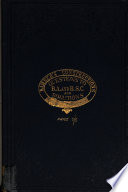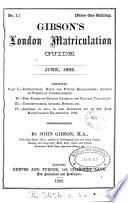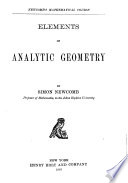 | Joseph Wolstenholme - Mathematics - 1878 - 538 pages
...satisfied and a fixed plane be drawn perpendicular to each straight line, the locus of a point which moves so that the sum of the squares of its distances from the planes is constant will be a sphere having a fixed centre 0 which is the centre of inertia of equal... | |
 | Civil service - 1878 - 228 pages
...geometrically, that A Yj and AYa are together equal to the distance of P from the axis. 5. A straight line moves so that the sum of the squares of its distances from the two points A and B at a distance 2a apart is equal to rf2. Prove, either analytically or geometrically,... | |
 | De Volson Wood - Geometry, Analytic - 1882 - 360 pages
...the sum of the squares of its distances from the sides of an equilateral triangle is constant. 3?. If a point moves so that the sum of the squares of its distances from any number of fixed points is constant, show that the locus will be a circle. 38. Find the equation... | |
 | William Elwood Byerly - Calculus - 1879 - 300 pages
...> un is a maximum. D*0«o=0 2= or>0 u0 is a minimum. EXAMPLES. 224. (1) To find a point so situated that the sum of the squares of its distances from the three vertices of a given triangle shall be a minimum. Let (o;i,.Vi)» (2^y2) , (xs,y3) be the given vertices,... | |
 | Thomas Kimber - 1880 - 176 pages
...of x, and the radius of which is equal to a. Interpret each of the equations а? + y* = 0 and of — y* = 0. A point moves so that the sum of the squares...circle. 15. Investigate the equation to a parabola, y' = 4 a x. Explain the geometrical meaning of the constant a. Trace the form of the curve from its... | |
 | Edward Albert Bowser - Geometry, Analytic - 1880 - 334 pages
...vertex. [Take the base and a perpendicular through its centre for axes.] Ans. ж2 + у2 = s2 — m2. 23. A point moves so that the sum of the squares of its distances from the four sides of a square is constant; show that the locus of the point is a circle. 24. Find the locus... | |
 | 1882 - 376 pages
...straight lines. 9. Inscribe a regular pentagon in a given circle. 10. Find the locus of a point which moves so that the sum of the squares of its distances from four given points is constant. What is the least possible value of this constant. ANSWEES TO THE GEOMETRY... | |
 | Charles Smith - Conic sections - 1883 - 388 pages
...the axis ACA', in the point Y; show that CY is parallel to A'P^ C being the centre of the CMirve. 3. A point moves so that the sum of the squares of its distances from two intersecting straight lines is constant. Prove that its locus is an ellipse, and find the eccentricity... | |
 | Charles Smith - Geometry, Analytic - 1884 - 256 pages
...tangent planes of three conicoids meet in a point, the other four will also meet in a point. 13. A plane moves so that the sum of the squares of its distances from two of the angles of a tetrahedron is equal to the sum of the squares of its distances from the other... | |
 | Simon Newcomb - Geometry, Analytic - 1884 - 462 pages
...11. What curve does p = a cos (6 — a) + b cos (d — ft) + c cos (d — y) + . . . represent? 12. A point moves so that the sum of the squares of its distances from the four sides of a rectangle is constant. Show that the locus of the point is a circle. 13. Given the... | |
| |